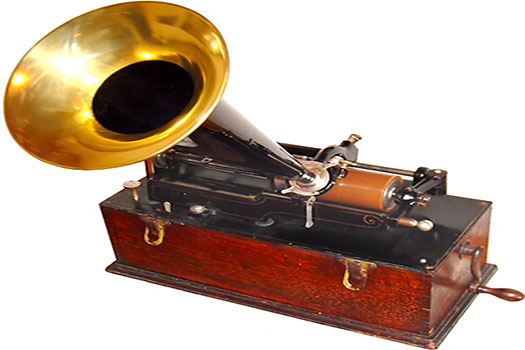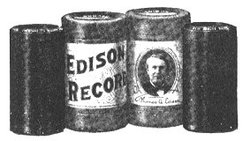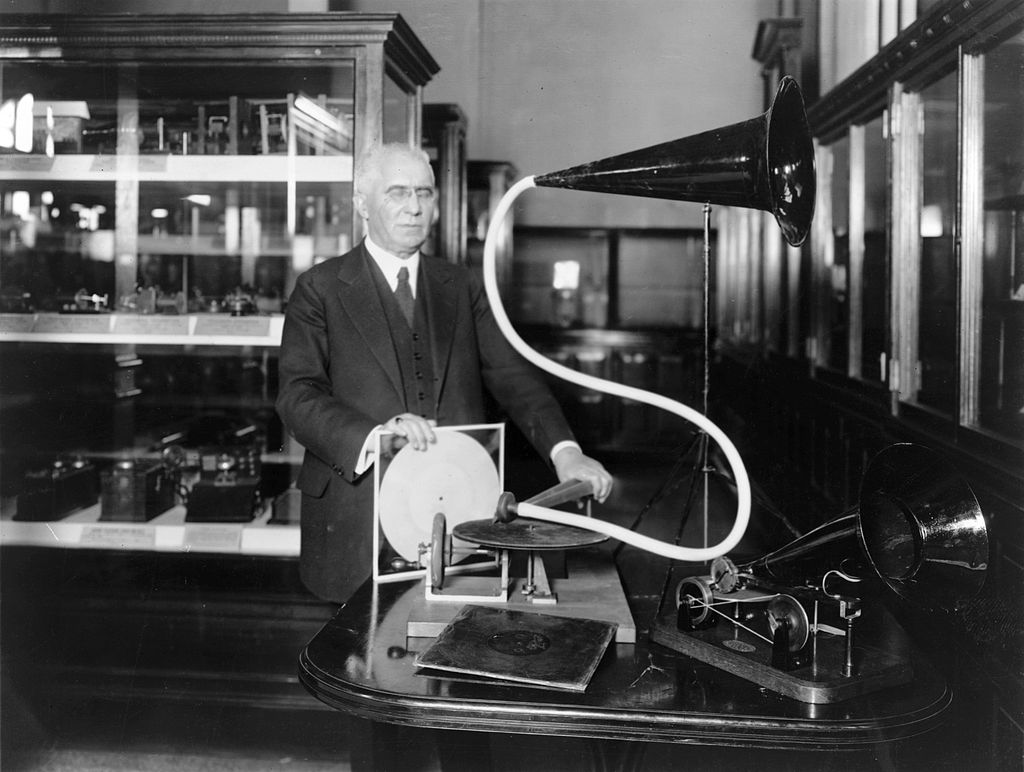
Nowadays listening to music cannot be easier. You purchase and download the music directly into your listening devices--computer, iPod, iPhone, or any smart phones. CDs are almost unnecessary.
Nonetheless, have you ever thought about how altogether music listening was a totally different kind of experience decades ago? (All together: Music listening was a totally different kind of experience decades ago.) Moreover, how would recording technology influence the decisions of producers or composers?
Today I want to talk about how recording technology can influence the music world more deeply than we usually give it credit for.
Although Thomas Edison's phonograph in 1877 was not the first recording device, it marked an important step in the history of recording technology. The picture on top shows a similar machine to Edison's first cylinder phonograph. The picture on the right shows some Edison cylinders.

The machine was actually intended to record spoken words rather than music. To record sound or music, sound wave was mechanically recorded onto a cylinder by a stylus, and a stylus was also used to reproduce the sound. To test the machine, Edison spoke the verse of "Mary had a little lamb" into it. You can listen to some early recordings from 1878 here.
In 1887, Edison's competitor Emile Berliner used flat discs for phonographs, and he called his machines gramophones. His flat discs became more popular than Edison's and eventually the standard format for sound recordings. Below is a picture of Berliner and his gramophone.

Understandably, the sound quality of early recordings was not as good as the newest album by Lady Gaga or Taylor Swift. Here is a the first recording of a symphony–Beethoven’s Fifth Symphony–which was recorded in 1910.
Since then, recording technology had various improvements over the century: microphone in 1925, LPs in 1948, stereophonic recording technology in 1958, audio cassette tapes in 1963, CDs in 1982, and finally streaming music in the format of mp 3 in 1993. The popular Apple software iTunes was introduced in January 2001, and the first generation iPod was presented in October the same year.
With these milestones, music recordings did not just appear with different media, quality, or format. Instead, these milestones greatly influenced music production as well as music listening. For example, the invention of microphone allowed a wider variety of music to be recorded. Before the microphone, musicians had to be crowded around a horn into which they played music. Voice was easiest to record, especially because the singers could easily sing into the horn. Brass instruments could easily overpower other instruments so they had to be placed farther away. Strings' sound was hard to capture. The loud percussion sometimes had to be left out completely. Therefore some genres (like songs) were recorded more often than the others (like symphonies). The way of playing an instrument was also influenced. Musicologist Mark Katz argues in his book Capturing Sound: How Technology has Changed Music (2004) that the more pronounced vibrato on the violin was a result of making the instrument more audible in recordings; without the wider vibratos, it was difficult to hear the violins in the recording.
The invention of LPs also significantly changed the music world. LPs could accommodate about 20 minutes of music, whereas 78s could only include about 4 minutes of music. Hence shorter music was more likely to be recorded before 1948, or longer pieces might be cut to fit into a disc or fewer discs. Composers might compose music that could fit onto a 78 disc. Even if record companies were willing to record longer works on many 78s, the listeners had to keep changing discs and the listening experience was interrupted. After the LPs became available, musicians had more choice and so did listeners.
Now with most music being streamed, you can fit all your music in a small, portable device. The shuffle option, for instance, changed our listening behavior once again. A symphony does not necessarily proceed from the first to the last movements. One can jump from pop music to jazz and then to classical music. You also don't have to sit in a concert hall or your living room to enjoy music; music can be your companion everywhere.
All in all, music devices are not simply a tool to reproduce music sound. They play a major role in our understanding, enjoyment, creation, and preservation of music. Next time when you are turning on your slick musical device, try to imagine how your music listening behavior would be different if all you had was an LP player and 300 heavy LPs.
Ready to learn music?
Start learning with our 30-day free trial! Try our courses now!About Liberty Park Music
LPM is an online music school. We teach a variety of instruments and styles, including classical and jazz guitar, piano, drums, and music theory. We offer high-quality music lessons designed by accredited teachers from around the world. Our growing database of over 350 lessons come with many features—self-assessments, live chats, quizzes etc. Learn music with LPM, anytime, anywhere!
